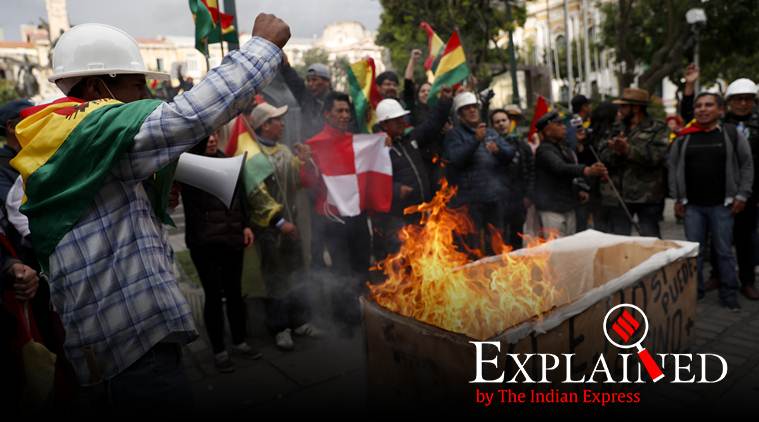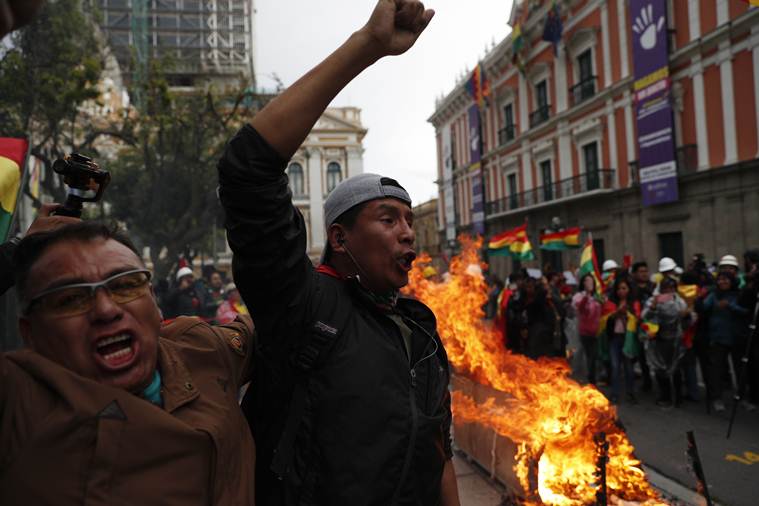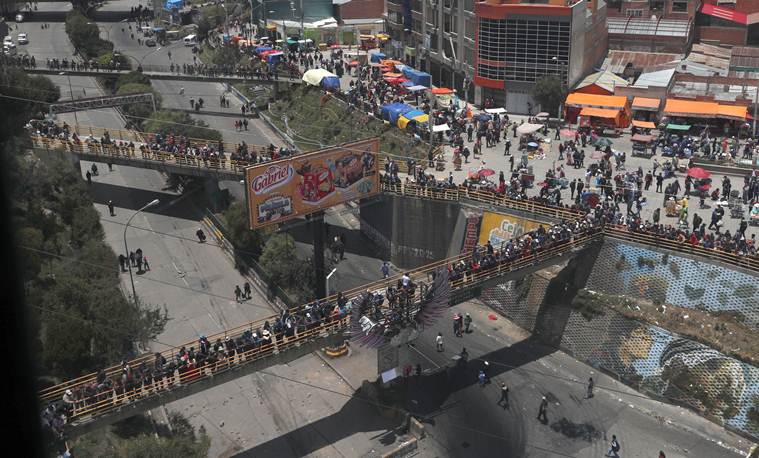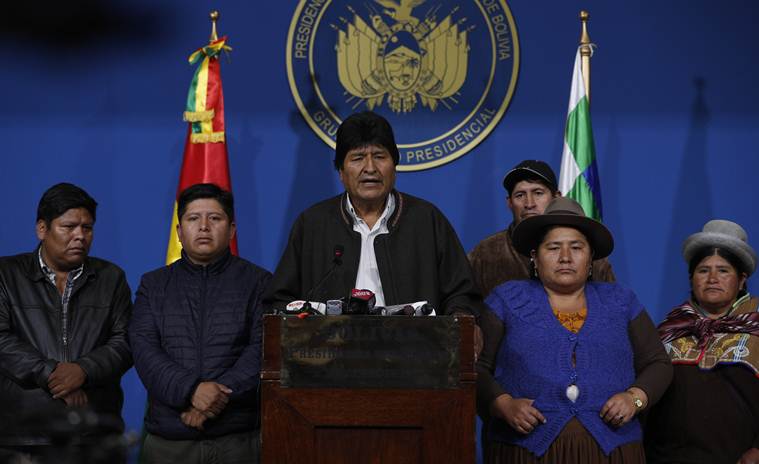Explained: Why Bolivia is the latest South American nation to fall into chaos
Bolivian President Evo Morales, whom the elections had brought to power for a fourth term, has said he has been the target of a coup, and has alleged the role of a “civic-political-police” conspiracy to remove him from power.
 Opponents of Bolivia’s President Evo Morales celebrate after he announced his resignation in La Paz, Bolivia. (AP Photo)
Opponents of Bolivia’s President Evo Morales celebrate after he announced his resignation in La Paz, Bolivia. (AP Photo)
Bolivian President Evo Morales resigned on Sunday, forced out of power by massive protests that had rocked the country for 18 days over alleged discrepancies in the general election held last month.
The leader of the South American country, whom the elections had brought to power for a fourth term, has said that he has been the target of a coup, and has alleged the role of a “civic-political-police” conspiracy to remove him from power.
Why was Bolivia’s election thought to be unfair?
Morales, Bolivia’s first President of indigenous origin, had been at the country’s helm since 2006. The socialist leader has been credited with bringing economic stability to the Andean nation, and continues to remain popular among rural voters.
In 2016, a referendum put in place term limits to office, but Morales successfully appealed against the verdict in Bolivia’s top court, and was able to contest for the fourth time this year.
The elections were held on October 20, and initial results showed a tight race between Morales and his rival Carlos Mesa, a former President.
Soon after, however, the publication of the results by the election body was abruptly stopped for 24 hours. After it resumed, Morales was shown as leading by a greater margin, a lead of more than 10%.
In the Bolivian system, if the margin between the top two candidates is less than 10%, a runoff or second election is held between them.
The results were seen with suspicion, and protesters rallied on the streets. The anger was fuelled on October 22, when a member of the Bolivian election body resigned.
 The election results were seen with suspicion, and protesters rallied on the streets. (AP Photo)
The election results were seen with suspicion, and protesters rallied on the streets. (AP Photo)
On October 25, the election authorities affirmed Morales’s election victory, giving him 47.1% of the total vote share, with a lead of more than 10% over Mesa. The affirmation further irked protesters.
The United States, Brazil, Argentina, and Colombia urged Bolivia to conduct a second round of voting. The Organisation of American States (OAS), a group consisting of all the major powers in the region, decided to conduct an audit of the October 20 elections.
What happened after the OAS released its report?
The preliminary report of the OAS picked up several irregularities in the election process, the Madrid-based El País reported.
The report spoke of “clear manipulation”, and noted the blackout which interrupted the transmission of results on October 20, after which Morales was shown to lead with a bigger margin over his opponent Mesa.
 Supporters of Bolivian President Evo Morales stand on pedestrian bridges as they block a road that connects La Paz and El Alto, to show their support for his apparent re-election in El Alto, Bolivia. (AP Photo)
Supporters of Bolivian President Evo Morales stand on pedestrian bridges as they block a road that connects La Paz and El Alto, to show their support for his apparent re-election in El Alto, Bolivia. (AP Photo)
The OAS also said that the data was directed from an unplanned external server, and observed irregularities in the counting of votes.
Morales said that the report was more “political” than technical, but announced fresh elections on Sunday to allay public anger. This failed to de-escalate the situation, which had flared up considerably by then, with the police also joining the demonstrations two days before on November 8.
In a significant move, the military also said that it would not “repress the people”, local news outlet El Diario reported.
In the face of stiff resistance, Morales tendered his resignation, saying, “I am resigning so that Mesa and Camacho (the leader of the protests) do not continue to mistreat the relatives of our colleagues, do not continue attacking ministers and deputies, and so that they stop mistreating the poorest.”
 Morales, Bolivia’s first President of indigenous origin, had been at the country’s helm since 2006. (AP Photo)
Morales, Bolivia’s first President of indigenous origin, had been at the country’s helm since 2006. (AP Photo)
What happens now?
An editorial in El País on November 11 explained, “The situation that faces institutions is one of a dangerous power vacuum, the latter must be reshaped institutionally and democratically as soon as possible. The presidents of the Senate and the Chamber of Deputies — who could have legally taken over the leadership of the State until the next elections — have also resigned, and the leader of the protests, Luis Fernando Camacho, has proposed the formation of a government board consisting of the military and police high command. This is a formula that, unfortunately, evokes the rhetoric of coups belonging to an era that Bolivia must have left behind.”
Don’t miss from Explained | Mumbai: How a new flyover cuts commute time in the city drastically
- 01
- 02
- 03
- 04
- 05






































